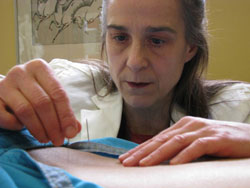Research Science
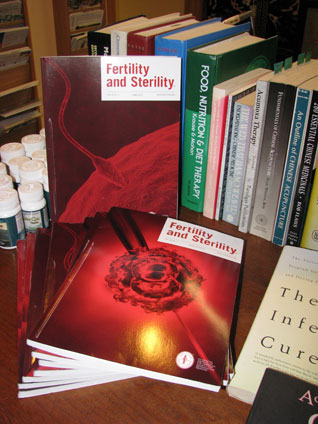
Dr. Mudrak's research has covered the areas listed and summarized in the graphs below. In general, acupuncture is best used to promote pregnancy in cases of: luteal phase defect, irregular menstrual cycles, hormone imbalances, ovulation disorders including anovulatory women and those with PCOS, unexplained infertility and, of course, to significantly improve the pregnancy outcome in women undergoing assisted reproductive technologies such as IVF and ICSI. The research proposes that acupuncture facilitates the release of opioids and other peptides from the hypothalamus, pituitary and ovaries impacting the B-endorphin levels and in turn GnRH secretion and the menstrual cycle. The inhibition of the sympathetic nervous system is also established as contributing to the effects of acupuncture in both increasing blood flow to the uterus and reducing stress and anxiety.
Note: Please contact Dr. Laura Mudrak for permission to use or reproduce any of the following graphs or research reports.
1. There is a Strong Positive Influence of Acupuncture on the Pregnancy Rate in Patients Who Undergo Assisted Reproduction Therapy (ART) via In Vitro Fertilization (IVF)
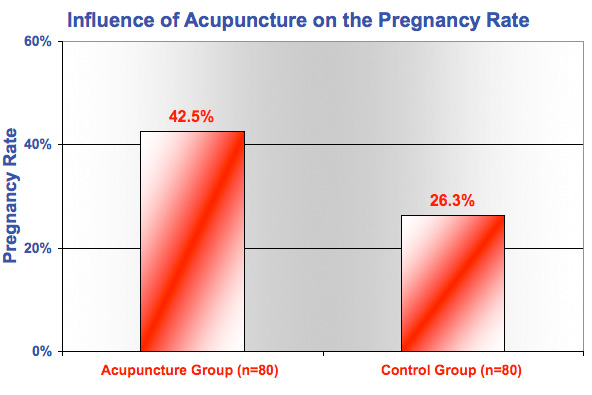
The group of infertile women undergoing assisted reproductive therapy via In Vitro Fertilization (IVF) who received a 25-minute session of acupuncture immediately before and after embryo transfer had a 60% higher rate of pregnancy than the IVF control group who were matched for all other co-variants but had not received acupuncture.
Paulus M.D., Wolfgang E., Zhang M.D., Mingmin, Strehler M. D., Erwin, El-Danasouri PhD, Imam, and Sterzik M.D., Karl (2002), "Influence of Acupuncture on the Pregnancy Rate in Patients who Undergo Assisted Reproduction Therapy", Fertility and Sterility, vol. 77, no. 4, April, 2002.
2. Acupuncture on the Day of Embryo Transfer (ET) Significantly Improves the Reproductive Outcome in Infertile Women: A Prospective Randomized Trial

The group of infertile women receiving a 25-minute acupuncture treatment before and after embryo transfer (ET) had a 50% higher clinical pregnancy rate than the control group of women who had not received acupuncture with ET.
Westgaard, L. G., Mao, Q., Krogslund, M., Sandrini, S., Lenz, S., and Grinsted, J. (2006) "Acupuncture on the Day of Embryo Transfer Significantly Improves the Reproductive Outcome in Infertile Women: a Prospective, Randomized Trial", Fertility and Sterility, vol. 85, no. 5, pp. 1341-1346, April, 2006.
The reproductive outcome following ET of the acupuncture group versus the control group was even more significant in terms of the rate of ongoing pregnancies and live births.
3. Acupuncture has a large increase on the pregnancy rate in "Effect of Acupuncture on the Outcome of In Vitro Fertilization (IVF) and Intracytoplasmic Sperm Injection (ICSI): a Randomized Prospective, Controlled Clinical Study"
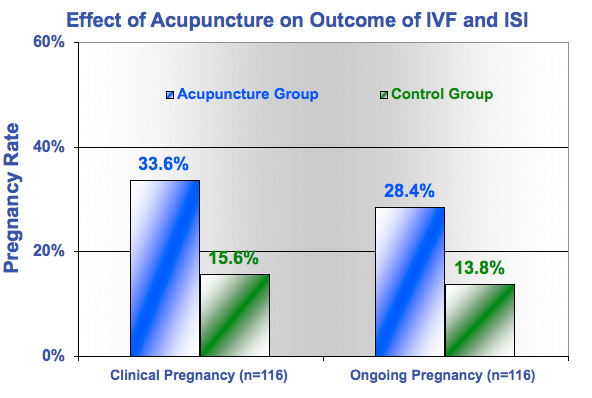
The group of infertile women who received luteal-phase acupuncture had an 115% increase in the rate of clinical pregnancy and a 105% increase in the rate of ongoing pregnancy than the control group of women not receiving acupuncture. Luteal-phase acupuncture has a positive effect on the outcome of assisted reproductive therapies of both In Vitro Fertilization and Intracytoplasmic Sperm Injection.
Dieterle, S., Ying, G., Hatzmann, W., and Neuer, A. (2006) "Effect of Acupuncture on the Outcome of In-vitro Fertilization and Intracytoplasmic Sperm Injection: a Randomized Prospective, Controlled Clinical Study", Fertility and Sterility, vol. 85, no. 5, pp. 1347-1351, April, 2006.
4. Auricular Acupuncture in the Treatment of Female Infertility Increases the Rate of Pregnancy by over 25% Compared to the Use of Harmone Therapy
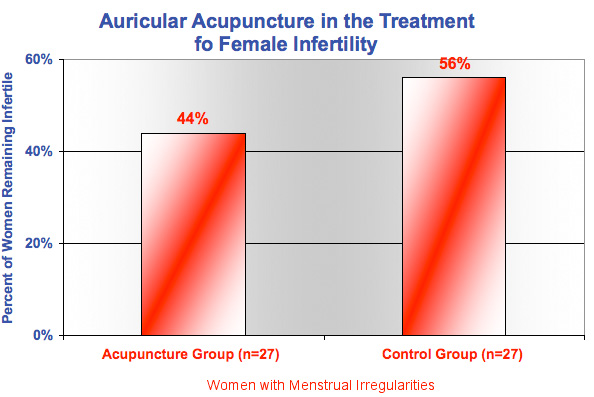
In the acupuncture group, 44% of the women with menstrual irregularities (olgioamenorrhea or luteal phase insufficiency) remained infertile compared with 56% of women in the hormone therapy control group. This documents a 25% increase in pregnancy rate due to the use of auricular acupuncture versus the use of hormone therapy. Various disorders of the autonomic nervous system normalized during acupuncture. Based on these data, auricular acupuncture seems to offer a valuable alternative therapy for female infertility due to hormone disorders: low estrogen, thyrotropin (TSH) and dehydroepiandrosterone (DHEAS) concentrations. These hormone disorders, and other infertility issues including endometrisis, and reduced post-coital and out of phase endometrial, were initially more pronounced in the acupuncture group than the control group.
Gerhard, I. and Postneek, F. (1992) "Auricular Acupuncture in the Treatment of Female Infertility", Gynecol Endocrinol, pp. 171-181, September, 1992.
5. Increased Blood Flow to the Uterus due to Acupuncture is Supported in the Reduction of Blood Flow Impedance in the Uterine Arteries of Infertile Women with Electro-Acupuncture (EA) when measured by Electro-Acupuncture (EA) Influence on Pulsatility Index (PI)
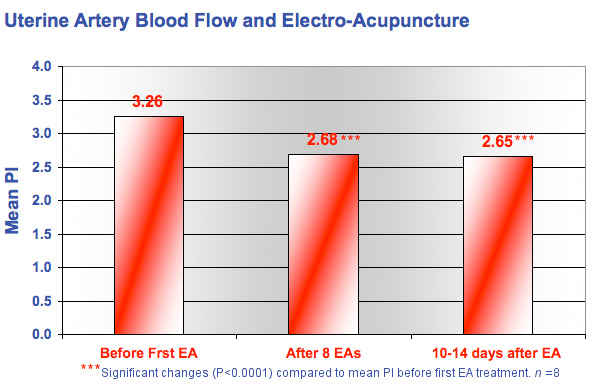
The decrease of the pulsatility index (PI) from a before electro-acupuncture (EA) mean value of 3.26 to an after eight EA mean value of 2.68 could be crucial to the success of achieving pregnancy via In Vitro Fertilization (IVF), as previous studies support that uterine receptivity is improved when the PI value is between 2.00 and 2.99 on the day of embryo transfer. The lower PI in the uterine arteries is associated with an increased pregnancy rate following IVF embryo transfer.
Sterner-Victorin, Elisabet, Waldenstrom, Urbam, Andersson, Sven A., and Wikland, Matts (1996), "Reduction of Blood Flow Impedance in the Uterine Arteries of Infertile Women with Electro-acupuncture", Human Reproduction, vol. 11, no. 6, pp. 1314-1317. Most importantly, PI is inversely related to uterine artery blood low, so a lower PI is directly related to higher uterine artery blood flow and increased uterine receptivity regardless of method of attempted pregnancy. In conclusion, EA has the potential to positively increase pregnancy rate.
6. Acupuncture Increases Sperm Motility via Increases in the Levels of Metenkephalins in the Semen.
If sperm motility is a concern, studies have shown that acupuncture is effective for enhancing the motility through increased levels of metenkephalins in the semen.* There are additional studies linking the presence of the metenkephalins to sperm motility.**
* Bensoussan A., The Vital Meridian. Churchill Livingstone, Melbourne, 1990, p. 112.
** Fujisawa M., Kanzaki M., Okada H., Arakawa S., Kamidono S., "Metenkephalin in Seminal Plasma of Infertile Men". International Journal of Urology, 3(4):297-300, 1996.
To enhance male fertility, acupuncture, even applied short term for the man experiencing sperm motility issues, is potentially of great benefit to fertility of the couple when timed with the ovulation of the female partner.
7. Enhanced Reproductive Success and the "Role of Acupuncture in the Treatment of Female Infertility"
Researchers from Weill Cornell Medical Center conducted a literature review published in Fertility and Sterility [1] (the premier medical journal devoted to fertility and reproductive medicine published by the ASRM) examining the scientific basis of mechanisms by which acupuncture:
- Increases blood flow to the uterus, thus improving the conditions for an ovum to implant on the uterine wall;
- Normalizes the endocrine system and production of hormones that regulate ovulation, especially in women with polycystic ovarian syndrome (PCOS);
- Positively affects the hypothalamic-pituitary-ovarian axis leading to effective communication and function of the reproductive organs;
- Regulates menstrual cycle; and
- Inhibits the sympathetic nervous system, allowing the parasympathetic release of opiates and beta-endorphins, which promote the sense of emotional well being by reducing anxiety and emotional distress while increasing relaxation.
[1] Chang M.D., Raymond, “Role of Acupuncture in the Treatment of Female Infertility”, Fertility and Sterility, vol. 78, no. 6, 2002, pp. 1149-1153.
The Human Reproduction Journal [16] published a study that measured the effects of electro-acupuncture on the pulsatility index (PI) of the uterine arteries on infertile women using transvaginal untrasonography to determine its effect on blood flow to the uterus. The acupuncture treatments significantly reduced the PI, which directly reduces blood flow impedance. PI is inversely related to uterine artery blood flow, so a lower PI is directly related to higher uterine artery blood flow and increased uterine receptivity regardless of method of attempted pregnancy. This finding is critical in determining acupuncture to positively increase the outcome of ART because increased blood flow to the uterus directly increases the success of other reproductive techniques such as in-vitro fertilization (IVF) and embryo transfer which demands optimal endometrial receptivity at the time of implantation.
The increased blood flow to the uterus resulting from the acupuncture was explained by E. Stener-Victorin et al. [16] to be mediated by inhibitors of the sympathetic nervous system.
Research by Stener-Victorin et al. [16] supporting the efficacy of electro-acupuncture in stimulating ovulation with anovulatory cycles and/or polycystic ovary syndrome (POS) revealed that the percentage of ovulatory cycles in all subjects improved 51% after 3 months of treatment.
Understanding of how acupuncture stimulates ovulation and its success in treating ovulation disorders is detailed in studies from China in the Journal of Traditional Chinese Medicine [12]. The effect of acupuncture influencing plasma levels of lutenizing hormone (LH), follicular stimulating hormone (FSH), progesterone (P), and estradiol have been measured, [38] and the mechanisms of acupuncture stimulating ovulation have been studied and quantified.[14]

